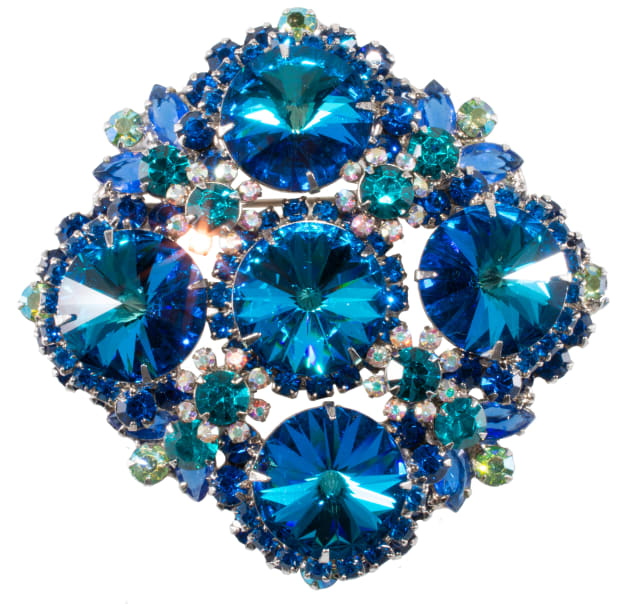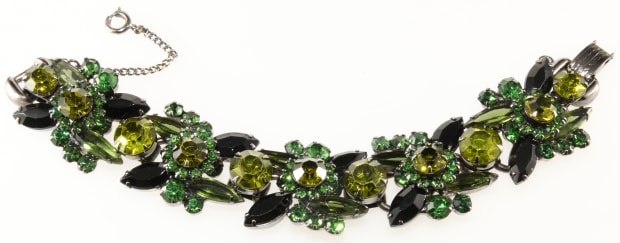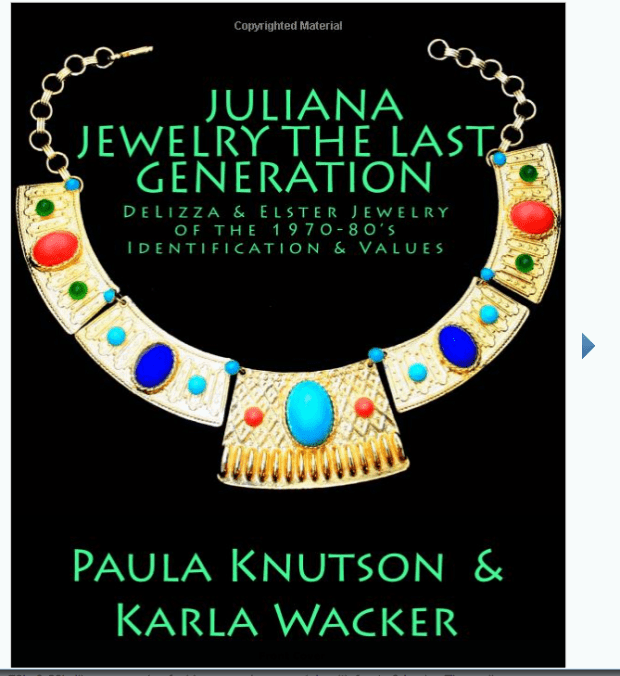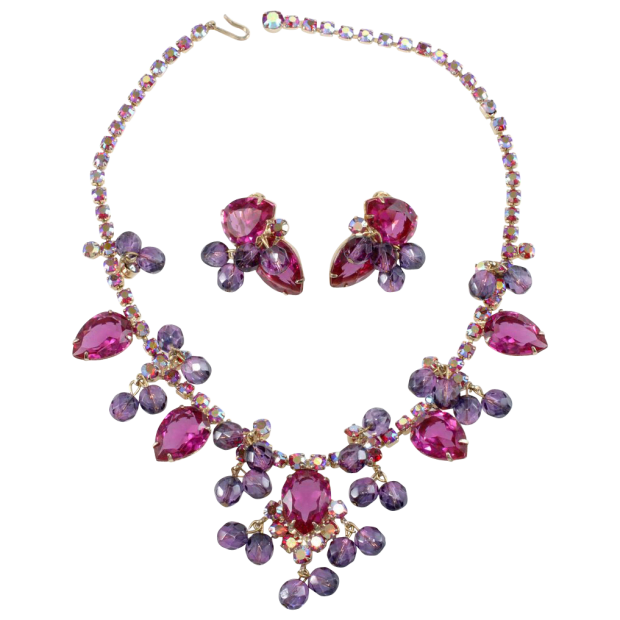#Identify #Juliana #Jewelry
As promised, I’m following up on my last article on unmarked costume jewelry with more specifics about Juliana jewelry made by DeLizza & Elster. The first thing to note is that Juliana-mania has waned a bit over the past five years or so. This isn’t surprising as more and more people learned about this type of unmarked jewelry and avid buyers completed collections of all but the rarest designs. As a result, prices have more or less stabilized.
The good news for folks with a stash of unmarked jewelry they haven’t researched yet is that even the most common Juliana pieces still hold more value than you might expect at first glance. There are also a number of popular designs selling for more than decent sums as well. Learning how to recognize them can be a valuable skill to master. There’s also some interesting background to cover as well.
Photo courtesy of Jay B. Siegel
What’s in a Name
In the early 2000s, a group of collectors started piecing the D&E story together by noticing original tags and cards still attached to jewelry with the same type of styling, construction techniques, and unique stones. Because the tags often read Juliana, individuals buying, selling, and collecting costume jewelry at the time started using that nickname to describe those pieces.
Not long thereafter, an avid collector named Cheryl Killmer made contact with Frank DeLizza. She, along with other jewelry historians who subsequently interviewed him, found out that the original “Juliana” was DeLizza’s mother. They also determined that a very limited number of styles were sold on paper cards or with hang tags reading Juliana, and only for one year in 1967. Many other pieces D&E made throughout the 1960s share the same construction techniques and similar components, however.
Collectors were so enthused about this type of jewelry, and honoring the company that made it, they argued about whether it should be called by its nickname, Juliana, or by the manufacturer’s name, DeLizza & Elster. When I asked Mr. DeLizza at a convention for jewelry collectors how he felt about this controversy, he replied, “A rose is a rose.” Today people often use the names Juliana and D&E together. Not all jewelry made by D&E reflects what we think of as traditional Juliana styling though.
It also helps to know that D&E manufactured jewelry for a number of other companies. Many unmarked pieces we now identified as Juliana were delivered to consumers through direct sales reps called “fashion directors” who worked for a business named Tara. Sometimes those pieces are found with Tara hang tags still attached. Gloria is another company name found on D&E hang tags. Most unmarked D&E jewelry, however, was wholesaled to department stores during the 1960s.

Photo courtesy of Jay B. Siegel
Identifying Juliana Jewelry
When getting down to the nuts and bolts of identifying Juliana pieces, there are some distinct characteristics savvy shoppers learn to spot. First, they look for five-link and band construction on bracelets. Turning a piece over and finding that special type of linking makes it easy to peg a bracelet as Juliana.
Keep in mind, however, that D&E made other types of bracelets as well including elaborate hinged bangles. These often have a distinct scrolling on the metalwork and a side opening. When you see one correctly identified as Juliana, they’re easy to spot going forward.

Photo courtesy of Jay B. Siegel

Photo courtesy of Jay B. Siegel
Other pieces present more of a challenge. Juliana aficionados often look for what has been nicknamed “figure eight” puddling in the soldering on the reverse as a next step. Many brooches and earrings can be identified by recognizing this construction technique.
Some Juilana pieces are also known for the unusual and vividly colored stones that were used in the designs. Among these are “Easter egg” stones which were actually named stippled cabochons by stone manufacturers due to their unique textured finish. “Watermelon” stones, named Vitrail Medium II by Swarovski, flashing hues of green and pink are also popular. And then there are margarita stones with scalloped edges and rivoli stones with pointed tops and foiled backs which are also quite eye-catching. These are just a few of the intriguing specialty stones used by D&E.
They also employed heavy rivets to hold pieces with layered construction together. This includes rhinestone floret embellishments that add dimension to a number of their styles. These rivets are used sparingly in comparison to other vintage brands. Pieces with many rivets (like those by Beau Jewels and Judy Lee) were made using a technique called swedging, which is an entirely different type of construction.
Dangling crystal beads are also a trademark of certain Juliana jewelry lines. Some of these were styles sold by Tara reps, especially those with clear rhinestones and iridescent beads as part of their “Fantasia” collection, so they are fairly common today. Brighter colors like royal blue, vivid red, and fuchsia are usually the most desirable although even the brown and black pieces with dangling elements are quite dramatic albeit less costly to acquire.
There are also specific types of decorative findings, closures, and earring backs used by D&E that advanced collectors hone in on when examining more obscure pieces.
Learning More About Juliana Jewelry
One of the most popular books on this topic is Juliana Jewelry Reference: DeLizza & Elster by Ann Pitman. Unfortunately, the price for this out-of-print title is so high that it is unattainable for most people. Look for The Art of Juliana Jewelry by Katerina Musetti as an alternative that is still in print. My book, Warman’s Costume Jewelry, also includes information on identifying Juliana jewelry. Another title covering atypical D&E jewelry is Juliana Jewelry: The Last Generation by Paula Knutson and Karla Wacker.

When looking for information online, Knutson and Wacker have a Facebook group called “Juliana (D&E) Jewelry Study Group” where members can learn from one another. They have also created a searchable database called “Is it Juliana Jewelry” that can be helpful. Sites where Juliana jewelry is sold are also useful when seeking comparable examples. Keep in mind, however, that some sites are better than others when it comes to keeping an eye on sellers erroneously representing pieces as Juliana. I recommend RubyLane.com as a good research resource for this reason.
Hopefully you’re now inspired to dig out all those unmarked pieces you’ve been planning to research and take a closer look. There’s a good chance your cache holds a piece or two of high-quality Juliana jewelry.
You May Also Like:
How to Identify Unmarked Costume Jewelry
Miriam Haskell: Costume Jewelry of the Stars
View the original article to see embedded media.

